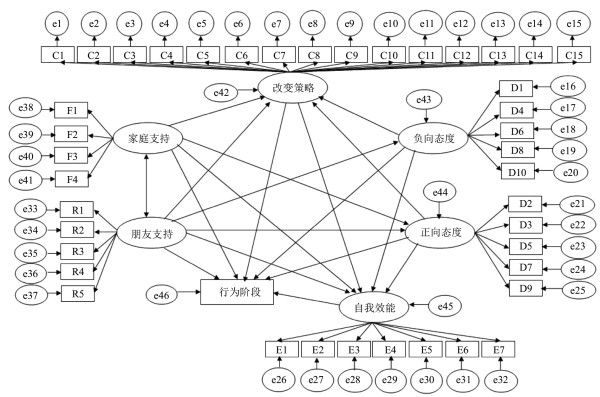青少年果蔬摄入行为与心理、社会因素结构模型
理解并接纳青少年的叛逆行为背后的原因 #生活技巧# #家庭教育建议# #青少年心理疏导#
许鸣, 骆湘香, 谢文倩, 朱茜如, 顾昉, 胡建江, 俞慧芳, 凌洁, 许亮文. 青少年果蔬摄入行为与心理、社会因素结构模型[J]. 中国公共卫生, 2018, 34(4): 540-544. DOI: 10.11847/zgggws1109834
引用本文: 许鸣, 骆湘香, 谢文倩, 朱茜如, 顾昉, 胡建江, 俞慧芳, 凌洁, 许亮文. 青少年果蔬摄入行为与心理、社会因素结构模型[J]. 中国公共卫生, 2018, 34(4): 540-544. DOI: 10.11847/zgggws1109834
Ming XU, Xiang-xiang LUO, Wen-qian XIE, . Association of fruit and vegetable intake behaviors with psychological and social factors among adolescents: an structural equation model analysis[J]. Chinese Journal of Public Health, 2018, 34(4): 540-544. DOI: 10.11847/zgggws1109834
Citation: Ming XU, Xiang-xiang LUO, Wen-qian XIE, . Association of fruit and vegetable intake behaviors with psychological and social factors among adolescents: an structural equation model analysis[J]. Chinese Journal of Public Health, 2018, 34(4): 540-544. DOI: 10.11847/zgggws1109834
青少年果蔬摄入行为与心理、社会因素结构模型
许鸣, 骆湘香1, 谢文倩1, 朱茜如1, 顾昉2, 胡建江3, 俞慧芳4, 凌洁4, 许亮文1, , 1.杭州师范大学医学院预防医学系,浙江省重点科技创新团队(2011R50021),浙江 杭州 310036
2.浙江省疾病预防控制中心
3.杭州市滨江区疾病预防控制中心
4.嘉兴市疾病预防控制中心
基金项目: 国家自然科学基金(71273079);教育部人文社会科学研究规划基金(11YJA880128)
详细信息
作者简介:许鸣(1990 – ),女,浙江杭州人,硕士在读,研究方向:健康教育
通讯作者:许亮文,E-mail:lwxu2006@163.com
中图分类号: R181.3+7
计量 文章访问数: 01626 HTML全文浏览量: 0455 PDF下载量: 089 出版历程 收稿日期: 2016-03-10 刊出日期: 2018-03-31Association of fruit and vegetable intake behaviors with psychological and social factors among adolescents: an structural equation model analysis
1.Department of Preventive Medicine,Medical College, Hangzhou Normal University, Hangzhou, Zhejiang Province 310036, China
摘要
摘要:
目的 构建青少年果蔬摄入行为与心理、社会因素的关系模型,探索心理、社会因素对青少年果蔬摄入行为阶段的影响机制与程度。
方法 2015年5月,利用分层整群抽样方法在浙江省杭州市和嘉兴市对1 858名中学生进行现场问卷调查,获取学生果蔬摄入行为阶段、相关心理因素、社会因素信息,用结构方程模型构建各潜变量与行为阶段之间的关系模型。
结果 模型拟合指标经反复校正后均达到较理想的水平(CFI = 0.941,RMSEA = 0.032),校正后模型显示朋友支持与正向态度对行为阶段只有间接效应,效应值为0.070、0.166;负向态度与自我效能对行为阶段只有直接效应,效应值为 – 0.096、0.252;家庭支持、改变策略对行为阶段既有直接效应,又有间接效应,总效应值分别为0.134、0.161。心理因素比社会因素对行为阶段的影响力更大,以自我效能为著。
结论 基于SEM方法,心理、社会因素对青少年果蔬摄入行为阶段的作用得到结构方程模型的有力支持。
Abstract:
Objective To construct a structural equation model (SEM) for describing the correlation of fruit and vegetable intake behaviors with psychological and social factors among adolescents and to explore the extent and mechanism of psychological and social influences on the behaviors.
Methods We conducted a questionnaire survey among 1 858 students (mean age = 15.06 ± 4.39 years) selected in two high schools in Hangzhou and Jiaxing city of Zhejiang province with stratified random cluster sampling in May 2015. Information on fruit and vegetable intake behaviors and related psychological and social factors were collected among the students. SEM was constructed to analyze the influences of potential variables on the stage of fruit and vegetable intake behavior.
Results The constructed model exhibited a good fit to the data collected, with a comparative fit index (CFI) of 0.941 and a root mean square error of approximation (RMSEA) of 0.032. The corrected model demonstrated that friend support and positive attitude only affected the stage of fruit and vegetable intake behavior indirectly, with the effect value of 0.070 and 0.166; in contrast, negative attitude and self-efficacy only affected the stage of fruit and vegetable intake behavior directly, with the effect value of – 0.096 and 0.252; while, family support and change in strategy affected the stage of fruit and vegetable intake behavior both directly and indirectly, with the total effect value of 0.134 and 0.161. The influence of psychological factors on the stage of fruit and vegetable intake behavior was much greater than that of social factors.
Conclusion Structural equation model can be well used to assess the influences of psychological and social factors on fruit and vegetable intake behaviors among adolescents quantitatively.
HTML全文

图 1 青少年果蔬摄入行为与心理、社会因素的初始结构模型

图 2 青少年果蔬摄入行为与心理、社会因素的结构模型修正后模型
注:图中数据为路径系数值。
表 1 调查对象果蔬摄入行为阶段的频数分布情况
项目前意向阶段意向阶段准备阶段行动阶段维持阶段χ2值P值人数%人数%人数%人数%人数% 性别男生41043.7120012.3216117.16505.3311712.4736.289< 0.001女生28230.6524026.0918420.00555.9815917.28年级初中32340.1718523.0118623.13566.97546.7286.971< 0.001高中36935.0125524.1915915.09494.6522221.06合计69237.2444023.6834518.571055.6527614.85表 2 模型拟合度判定标准及实际模型拟合指标结果
拟合度指标拟合度标准指标值 绝对拟合度 卡方自由度比(CMIN/DF)CMIN/DF值为1~3表示模型适配良好,若 > 5则需修正6.487 拟合优度指标(GFI)> 0.90以上良好0.850 调整拟合优度指数(AGFI)> 0.90以上良好0.831 近似误差平方根(RMSEA) < 0.05(适配良好),< 0.1(适配合理)0.054增值适配度指数 规范拟合指标(NFI)> 0.90以上良好0.857 增值适配指数(IFI)> 0.90以上良好0.876 Tucker-Lewis(TLI)> 0.90以上良好0.867 比较拟合指数(CFI)> 0.90以上良好0.876
表 3 模型修正前后拟合指标情况
指标χ2/dfP值GFIAGFINFITLICFIRMSEA 初始值6.490< 0.0010.8500.8310.8570.8670.8760.054修正后2.952< 0.0010.9410.9300.9380.9530.9580.032评价标准1~3> 0.9> 0.9> 0.9> 0.9> 0.9< 0.05表 4 模型变量对行为阶段的标准化影响效应分析
维度正向态度改变策略自我效能行为阶段直接效应间接效应总效应直接效应间接效应总效应直接效应间接效应总效应直接效应间接效应总效应 朋友支持0.2180.0000.2180.2120.1130.3240.0000.1950.1950.0000.0750.075家庭支持0.2510.0000.2510.1210.1310.2520.1160.1780.2940.0000.0960.096正向态度0.5190.0000.5190.3280.1980.5260.0000.1770.177负向态度0.0000.0000.0000.0000.0000.0000.0000.0000.000– 0.0980.000– 0.098改变策略0.0000.0000.0000.3810.0000.3810.0740.1010.175自我效能0.0000.0000.0000.0000.0000.0000.2640.0000.264参考文献(14)
[1]Slattery ML, Anderson K, Curtin K, et al. Dietary intake and microsatellite instability in colon tumors[J]. Int J Cancer, 2001, 93: 601 – 607.
[2]Carty JL, Bevan R, Waller H, et al. The effects of vitamin C supplementation on protein oxidation in healthy volunteers[J]. Biochem Biophys Res Commun, 2000, 273: 729 – 735.
[3] 吴宪, 张杰, 方明珠, 等. 行为 – 心理测定量表对青少年水果蔬菜摄入的评价[J]. 营养学报, 2014(2): 174 – 179. [4] 徐莉, 许亮文, 毛晨佳, 等. 中文版青少年久坐行为量表在初中生应用的信度和效度研究[J]. 中华行为医学与脑科学杂志, 2010, 19(11): 1040 – 1042. [5] 张杰, 许亮文, 陈钊娇, 等. 青少年体育锻炼行为 – 心理测定量表中文版及其信度效度研究[J]. 中华流行病学杂志, 2013, 34(4): 50 – 54. [6]Prochaska JO, Diclemente CC. Stages and processes of self-change of smoking: toward an integrative model of change[J]. J Consult Clin Psychol, 1983, 51(3): 390 – 395.
[7] 郑祥荣. 青少年锻炼行为分阶段转变的制约因素及干预策略[J]. 福建师范大学学报: 自然科学版, 2009(6): 114 – 119. [8]Bandura A. Self-efficacy: toward a unifying theory of behavioral change [J]. Advances in Behaviour Research and Therapy, 1978, 1(4): 139 – 161.
[9] 周涛, 鲁耀斌. 结构方程模型及其在实证分析中的应用[J]. 工业工程与管理, 2006, 11(5): 99 – 102. [10] 荣泰生. AMOS与研究方法[M]. 重庆: 重庆大学出版社, 2010(8): 126 - 132. [11] 候杰泰, 温忠麟, 成子娟. 结构方程模型及其应用[M]. 北京: 教育科学出版社, 2004: 11-12. [12]Mun EY, Von EA, White HR. An SEM approach for the evaluation of intervention effects using pre-post-post designs[J]. Structural Equation Modeling A Multidisciplinary Journal, 2009, 16(2): 315 – 337.
[13] 徐俊芳, 韩伟, 陈景武. 医学生人格特征与心理健康关系的结构方程分析[J]. 中国学校卫生, 2010, 31(1): 41 – 43. [14] 彭绩, 周海滨, 程锦泉, 等. 糖尿病患病危险因素线性结构模型分析[J]. 中国公共卫生, 2003, 19(12): 1505 – 1506.施引文献
资源附件(0)

图(2) / 表(4)
计量 文章访问数: HTML全文浏览量: PDF下载量: 出版历程 收稿日期: 2016-03-10 刊出日期: 2018-03-31目录
网址:青少年果蔬摄入行为与心理、社会因素结构模型 https://www.yuejiaxmz.com/news/view/456690
相关内容
青少年的网络适应:结构、特征及影响因素青少年心理健康问题的影响因素及对策分析
青少年心理压力大的原因
增加蔬果摄入补充肝肺营养素.pptx
Diabetes Care:水果和蔬菜摄入增加不影响胰岛素抵抗
姜乾金:心理应激系统模型构建28年
青少年摄影教程
世卫建议每日摄入至少五份蔬果
情绪调节如何与青少年的心理健康相关联?
吃素,蔬菜,水果,青菜

